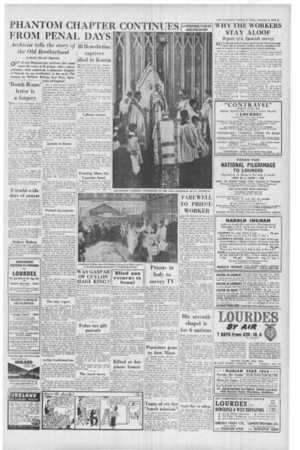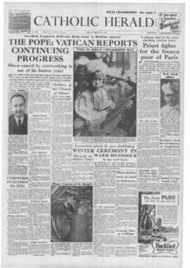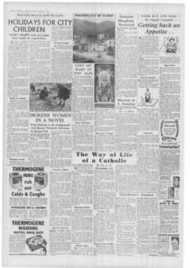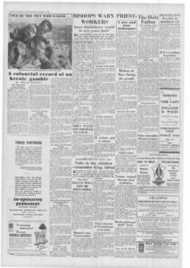Page 5, 5th February 1954
Page 5

Report an error
Noticed an error on this page?If you've noticed an error in this article please click here to report it.
Tags
Share
Related articles
Westminster Archives Giant Task Faces 'big Dig' Man A Small
Whitefriars Chronicle
All Sorts
Restoring The Canvas
Woman Archivist Appointed
PHANTOM CH PTER CONTINUES FROM PENAL DAYS
Archivist tells the story of the Old Brotherhood
'Catholic Herald' Reporter
OUT of the Westminster archives this week came the story of 18 priests—their names unknown—who constitute a phantom Chapter of Canons set up unofficially in the early 17th century by William Bishop, first Vicar Apos tolic of England.
We—a small group of Catholic pressmen—were sitting round the fire on Monday in the library of Archbishop's House, where the Hierarchy hold their Low Week meeting. listening to Fr. Bernard Fisher, the archivist, telling what he had shown a day or two earlier to a society of fellow-archivists.
All around, in glass cases and on tables, were documents telling the story of the Church in this country in Reformation and penal days. Within arm's reach was the golden crozier of the redoubtable Cardinal Allen.
Near by was an old handwritten list of priests who came with his blessing from Douai to minister in secret in their homeland, to be hunted, imprisoned and, many of them, put to death. The letter "M" after a name told the story of martyrdom.
Letters to Rome
Thousands of pages of letters, administrative and personal, carried the story from the Reformation through the penal days and on to the restoration of the Hierarchy.
Many arc letters to Rome addressed to agents of the Bishops and to the superiors of the religious orders, often written in peril of discovery by the priest-hunters. One of the most interesting of these is signed "R. Willard" and mentions a "Mr. Abraham." Mr. Willard was Bishop Challoner : Mr. Abraham was the Pope.
There were 16 lists of martyrs— two made by Thomas More, almost certainly a great-grandson of the martyr-Lord Chancellor; another by Bishop Challoner.
On another table we came to the Restoration and to Bulls signed by Pope Leo X111, Blessed Pope Pius X. Pope Pius Xi and the present Holy Father. Close by was another Bull signed by Pope Alexander IV when the Papal Court was resident in Viterbo (1261).
Wanted documents
In the midst of his growing enthusiasm as he described the treasures. Fr. Fisher's voice took on a note of regret as he told us of a collection of papers which would supplement the already large collection of documents covering the period 1631-8554 years.
They arc, he said, in the possession of the Old Brotherhood.
The pressmen. all of whom have served many years on Catholic newspapers, had never heard of the Old Brotherhood. Fr. Fisher explained.
William Bishop, wanting advisers, appointed a group of priests to form a Chapter. Apparently he had no authority from the Holy See to do so, and the Chapter was never officially recognised in Rome. It continued under Bishop Richard Smith.
When Bishop Smith went into exile, the Chapter continued nevertheless. They kept going by merely co-opting new members of their own choice, and their agent conducted business with the Holy See, without official recognition. And that is how the Old Brotherhood continues the phantom Chapter.
Who the members are Fr. Fisher could not tell us. Some questions brought the reassurance, however, that all is, of course, known to the Hierarchy;:and, indeed, it is held to be an honour to a diocese when one of its priests is co-opted. Priests so honoured are usually old; they are co-opted as a tribute to a lifetime's faithful service to the Church.
The only regret
To some extent the members live in the past; as members of the Brotherhood they think in terms not of dioceses but of districts—the London District, the Midland District. the Northern District and the Western District, which Pope Innocent XI created in 1688.
The only regret, it seems, is that the mine of information about the Church's heroic and desperate days contained in the Old Brotherhood's archives are not available outside the Brotherhood. The papers, it is believed, are kept in a London bank.
The one thing that appalled the archivist as he told his story was the fact that during one period of 54 years, 1631-85, and from 1558 to 1621 Confirmation was never administered in this country. The Archpriests, it seemed, while having authority over the secular clergy, did not have the faculty to administer the sacrament.
20,859 Confirmations
But obviously the ordinary people did not revere the sacrament less in its absence. For when Bishop Leyburn set to work in 1687 he confirmed 20,859 people between July 2 and October 14—that is, at the rate of about 200 a day for about 100 days.
There may even have been more than 20,859; Bishop Leyburn kept his records on separate pieces of paper and some of them may have been lost.
blog comments powered by Disqus









